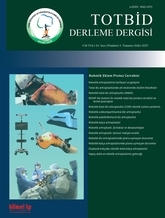
In recent years, the relative proliferation of the use of robotic systems in the field of surgery and orthopedics is the natural progression of a robotic evolution that began in the industrial field in the middle of the twentieth century. This robotic evolution has created great expectations in the field of surgery, especially in the field of arthroplasty. This expectation is basically a prolongation of implant survival, obtaining natural joint perception and decrease in complications. Starting from the first developments of robot-assisted surgery to its integration with today`s artificial intelligence and precision guidance systems, all robotic systems promise hope in terms of surgical results. With the help of data that will accumulate in the coming years, this hope is expected to be met with the rational analysis of the data and the developments in technology. Meanwhile examining the historical development of robotic systems in surgery and their evolution in the field of arthroplasty will facilitate the understanding of this technology that will shape the future.